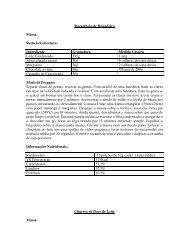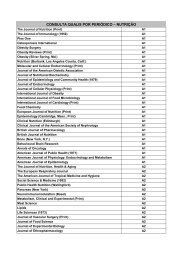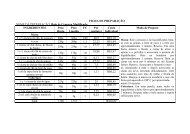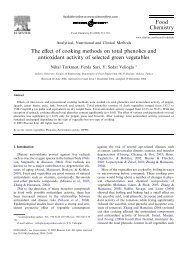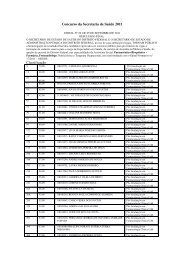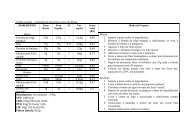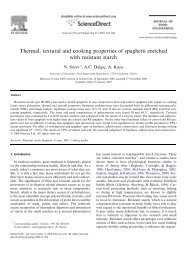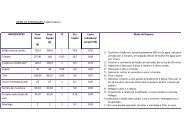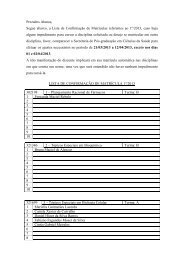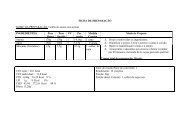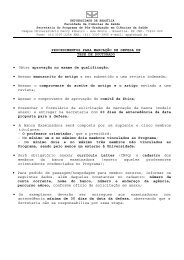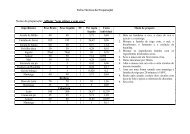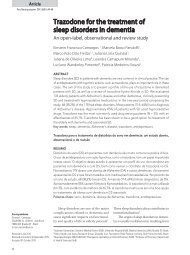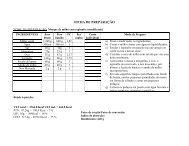Impact of different cooking methods on food quality: Retention of ...
Impact of different cooking methods on food quality: Retention of ...
Impact of different cooking methods on food quality: Retention of ...
You also want an ePaper? Increase the reach of your titles
YUMPU automatically turns print PDFs into web optimized ePapers that Google loves.
332 S. Bernhardt, E. Schlich / Journal <str<strong>on</strong>g>of</str<strong>on</strong>g> Food Engineering 77 (2006) 327–333<br />
clear that boiling leads to high losses while stewing,<br />
steaming, microwave <str<strong>on</strong>g>cooking</str<strong>on</strong>g> and even pressure steaming<br />
cause <strong>on</strong>ly small losses (Loh, 2004). Losses <str<strong>on</strong>g>of</str<strong>on</strong>g> minerals<br />
during <str<strong>on</strong>g>cooking</str<strong>on</strong>g> are not caused by destructi<strong>on</strong> but<br />
<strong>on</strong>ly by leaching into the <str<strong>on</strong>g>cooking</str<strong>on</strong>g> water (Miller, 1996).<br />
Leaching is also the main reas<strong>on</strong> for the high losses <str<strong>on</strong>g>of</str<strong>on</strong>g><br />
ascorbic acid during <str<strong>on</strong>g>cooking</str<strong>on</strong>g>. Different studies have<br />
found an decrease <str<strong>on</strong>g>of</str<strong>on</strong>g> ascorbic acid by boiling up to<br />
75% (Gould & Golledge, 1989; Petersen, 1993; Schnepf<br />
& Driskell, 1994).<br />
4. C<strong>on</strong>clusi<strong>on</strong>s<br />
By comparis<strong>on</strong> <str<strong>on</strong>g>of</str<strong>on</strong>g> the results <str<strong>on</strong>g>of</str<strong>on</strong>g> b-carotene and atocopherol<br />
it seems that similarities in localisati<strong>on</strong> lead<br />
to a similar behaviour during <str<strong>on</strong>g>cooking</str<strong>on</strong>g>.<br />
Cooking a green fresh vegetable promotes the release<br />
<str<strong>on</strong>g>of</str<strong>on</strong>g> lipophilic vitamins. Whereas in a red vegetable fruit<br />
respectively in the frozen vegetables which have passed<br />
a blanching step a decrease or no change occurs.<br />
For b-carotene it is known since l<strong>on</strong>ger that <str<strong>on</strong>g>cooking</str<strong>on</strong>g><br />
can increase the extractability and thereby probably improves<br />
the bioavailability <str<strong>on</strong>g>of</str<strong>on</strong>g> b-carotene from the vegetable<br />
matrix.<br />
Whereas for a-tocopherol it is still unclear how the<br />
<strong>food</strong> matrix influences absorpti<strong>on</strong> and bioavailability.<br />
The given results let assume that <str<strong>on</strong>g>cooking</str<strong>on</strong>g> leads also to<br />
a better availability <str<strong>on</strong>g>of</str<strong>on</strong>g> a-tocopherol from sources which<br />
are difficult to access.<br />
Between the single <str<strong>on</strong>g>cooking</str<strong>on</strong>g> <str<strong>on</strong>g>methods</str<strong>on</strong>g> no significant<br />
differences can be observed if <strong>on</strong>ly the results for the<br />
lipophilic vitamins are c<strong>on</strong>sidered. But if there is also<br />
paid attenti<strong>on</strong> in preserving hydrophilic compounds like<br />
ascorbic acid and minerals boiling should be avoided in<br />
favour <str<strong>on</strong>g>of</str<strong>on</strong>g> a <str<strong>on</strong>g>cooking</str<strong>on</strong>g> method with less water.<br />
References<br />
Arango, Y., & Heise, K. P. (1998). Localizati<strong>on</strong> <str<strong>on</strong>g>of</str<strong>on</strong>g> a-tocopherol<br />
synthesis in chromoplast envelope membranes <str<strong>on</strong>g>of</str<strong>on</strong>g> Capsicum annuum.<br />
I. Fruits. Journal <str<strong>on</strong>g>of</str<strong>on</strong>g> Experimental Botany, 49, 1259–1262.<br />
Bognár, A. (1989). Untersuchungen über den Einfluss der Temperaturund<br />
Verpackung auf den Genuss- und Nährwert v<strong>on</strong> frischem<br />
Gemüse und Obst bei der Lagerung im Kühlschrank. Ernährungs<br />
Umschau, 36, 254–263.<br />
Booth, V. H. (1963). a-Tocopherol, its co-occurrence with chlorophyll<br />
in chloroplasts. Phytochemistry, 2, 421–427.<br />
Booth, V. H., & Bradford, M. P. (1963). The effect <str<strong>on</strong>g>of</str<strong>on</strong>g> <str<strong>on</strong>g>cooking</str<strong>on</strong>g> <strong>on</strong> atocopherol<br />
in vegetables. Internati<strong>on</strong>al Journal <str<strong>on</strong>g>of</str<strong>on</strong>g> Vitamin Research,<br />
33, 276–277.<br />
Bramley, P. M., Kafatos, A., Kelly, F. J., Manios, Y., Roxborough, H.<br />
E., Schuch, W., et al. (2000). Review vitamin E. Journal <str<strong>on</strong>g>of</str<strong>on</strong>g> the<br />
Science <str<strong>on</strong>g>of</str<strong>on</strong>g> Food and Agriculture, 80, 913–938.<br />
Brubacher, G. (1966). Über den Vitamin E-Gehalt einiger Nahrungsmittel.<br />
Internati<strong>on</strong>ale Zeitschrift für Vitaminforschung, 38,<br />
409–415.<br />
Castenmiller, J. J. M., & West, C. E. (1998). Bioavailability and<br />
bioc<strong>on</strong>versi<strong>on</strong> <str<strong>on</strong>g>of</str<strong>on</strong>g> carotenoids. Annual Reviews <str<strong>on</strong>g>of</str<strong>on</strong>g> Nutriti<strong>on</strong>, 18,<br />
19–38.<br />
de Pee, S., West, C. E., Permaesih, D., Muhilal, S. M., & Hautvast, J.<br />
(1998). Orange fruit is more effective than are dark-green, leafy<br />
vegetables in increasing serum c<strong>on</strong>centrati<strong>on</strong>s <str<strong>on</strong>g>of</str<strong>on</strong>g> retinol and bcarotene<br />
in schoolchildren in Ind<strong>on</strong>esia. American Journal <str<strong>on</strong>g>of</str<strong>on</strong>g><br />
Clinical Nutriti<strong>on</strong>, 68, 1058–1067.<br />
Deming, D. M., Baker, D. H., & Erdman, J. W. (2002). The<br />
relative vitamin A value <str<strong>on</strong>g>of</str<strong>on</strong>g> 9-cis b-carotene is less and that <str<strong>on</strong>g>of</str<strong>on</strong>g><br />
13-cis b-carotene may be greater than the accepted 50% that <str<strong>on</strong>g>of</str<strong>on</strong>g><br />
all-trans b-carotene in gerbils. Journal <str<strong>on</strong>g>of</str<strong>on</strong>g> Nutriti<strong>on</strong>, 132,<br />
2709–2712.<br />
Deming, D. M., Teixeira, S. R., & Erdman, J. W. (2002). All-trans-bcarotene<br />
appears to be more bioavailable than 9-cis or 13-cis-bcarotene<br />
in gerbils given single oral doses <str<strong>on</strong>g>of</str<strong>on</strong>g> each isomer. Journal <str<strong>on</strong>g>of</str<strong>on</strong>g><br />
Nutriti<strong>on</strong>, 132, 2700–2708.<br />
Dietz, J. M., Kantha, S. S., & Erdman, J. W. (1988). Reversed phase<br />
HPLC analysis <str<strong>on</strong>g>of</str<strong>on</strong>g> a- and b-carotene from selected raw and cooked<br />
vegetables. Plant Foods for Human Nutriti<strong>on</strong>, 38, 333–341.<br />
DIN EN 12823-2, (2000). Bestimmung v<strong>on</strong> Vitamin A mit Hochleistungs-Fflüssigkeits-chromatographie.<br />
Bestimmung v<strong>on</strong> b-Carotin<br />
(Teil 2). Deutsches Institut für Normung e.V. Berlin: Beuth Verlag.<br />
Eitenmiller, R. R., & Landen, W. O. (1999). Vitamin analysis for the<br />
health and <strong>food</strong> sciences (pp. 223–270). Boca Rat<strong>on</strong>, L<strong>on</strong>d<strong>on</strong>, New<br />
York, Washingt<strong>on</strong>: CRC Press.<br />
Erdman, J. W., Poor, C. L., & Dietz, J. M. (1988). Factors affecting the<br />
bioavailability <str<strong>on</strong>g>of</str<strong>on</strong>g> vitamin A, carotenoids, and vitamin E. Food<br />
Technology, 42, 214–221.<br />
Esterbauer, H., & Hayn, M. (1997). Vitamin E. In H. K. Biesalski<br />
(Ed.), Vitamine: physiologie, pathophysiologie, therapie (pp. 41–58).<br />
New York: Thieme Stuttgart.<br />
Franke, W. (1997). Nutzpflanzenkunde (6. neubearb. Aufl). New York:<br />
Thieme, Stuttgart.<br />
Gould, M. F., & Golledge, D. (1989). Ascorbic acid levels in<br />
c<strong>on</strong>venti<strong>on</strong>ally cooked versus microwave oven cooked frozen.<br />
Food Sciences and Nutriti<strong>on</strong>, 42F, 145–152.<br />
Hart, D., & Scott, K. J. (1995). Development and evaluati<strong>on</strong> <str<strong>on</strong>g>of</str<strong>on</strong>g> an<br />
HPLC method for the analysis <str<strong>on</strong>g>of</str<strong>on</strong>g> carotenoids in <strong>food</strong>s, and the<br />
carotenoid c<strong>on</strong>tent <str<strong>on</strong>g>of</str<strong>on</strong>g> vegetables and fruit comm<strong>on</strong>ly c<strong>on</strong>sumed in<br />
the UK. Food Chemistry, 54, 101–111.<br />
Herrmann, K. (1994). Inhaltsst<str<strong>on</strong>g>of</str<strong>on</strong>g>fe der Kohlarten. Teil 1. Industrielle<br />
Obst- und Gemüseverwertung, 79, 244–252.<br />
Herrmann, K. (1996). Gemüse und Gemüseerzeugnisse. In F. Timm &<br />
K. Herrmann (Eds.), Tiefgefrorene Lebensmittel (2. Aufl., pp. 183–<br />
202). Berlin: Blackwell Wiss Verlag.<br />
Howard, L. A, W<strong>on</strong>g, A. D., Perry, A. K., & Klein, B. P. (1999). b-<br />
Carotene and ascorbic acid retenti<strong>on</strong> in fresh and processed<br />
vegetables. Journal <str<strong>on</strong>g>of</str<strong>on</strong>g> Food Science, 64, 929–936.<br />
IZ-Lufa-ITL, (1999). Bestimmung v<strong>on</strong> Vitamin C (Ascorbinsäure).<br />
Kesel, A. B., Junge, M. M., & Nachtigall, W. (1999). Einführung in die<br />
angewandte Statistik für Biowissenschaftler. Basel, Bosten, Berlin:<br />
Birkhäuser.<br />
Lessin, W. J., Catigani, G. L., & Schwartz, S. J. (1997). Quantificati<strong>on</strong><br />
<str<strong>on</strong>g>of</str<strong>on</strong>g> cis–trans-isomers <str<strong>on</strong>g>of</str<strong>on</strong>g> provitamin A carotenoids in fresh and<br />
processed fruits and vegetables. Journal <str<strong>on</strong>g>of</str<strong>on</strong>g> Agriculture and Food<br />
Chemistry, 45, 3728–3732.<br />
Lichtenthaler, H. K. (1969). Zur Synthese der lipophilen Plastidenchin<strong>on</strong>e<br />
und Sekundärcarotinoide während der Chromoplastenentwicklung.<br />
Berichte der Deutschen Botanischen Gesellschaft, 82,<br />
483–497.<br />
Loh, S., (2004). Bewertung des Einflusses verschiedener Garverfahren<br />
auf die sensorische und ernährungsphysiologische Qualität v<strong>on</strong><br />
frischen und TK-Gemüsen anhand ausgewählter Parameter. Cuvillier,<br />
Göttingen.<br />
Loh, S., & Schlich, E. (2003). Einfluss verschiedener Garverfahren auf<br />
die cis-/all-trans-ratio v<strong>on</strong> b-Carotin in Gemüse. Proceedings <str<strong>on</strong>g>of</str<strong>on</strong>g> the<br />
German Nutriti<strong>on</strong> Society, 5, 69.<br />
Miller, D. (1996). Minerals. In O. R. Fennema (Ed.), Food chemistry<br />
(3rd ed.). New York: Marcel Dekker.



